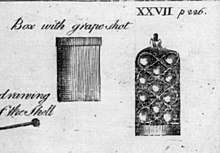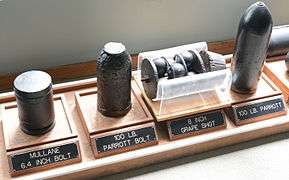Grapeshot
In artillery, grapeshot is a projectile that is not one solid element, but a geometric arrangement of round shot packed tightly into a canvas bag[1] and separated from the gunpowder charge by a metal disk of full bore diameter. It was used both in land and naval warfare. When assembled, the shot resembled a cluster of grapes, hence the name. On firing, the balls spread out from the muzzle, giving an effect similar to a giant shotgun.[2]


Grapeshot was devastatingly effective against massed infantry at short range, and was used against massed infantry at middle range. Solid shot was used at longer range and canister at shorter. When used in naval warfare, grapeshot served a dual purpose. First, it continued its role as an anti-personnel projectile. However, the effect was diminished due to a large portion of the crew being below decks and the addition of hammock netting in iron brackets intended to slow or stop smaller shot.[3] Second, the balls were cast large enough to cut rigging, destroy spars and blocks, and puncture multiple sails.[4][5]
Canister shot, also known as case shot fired a larger number of smaller projectiles loosely packaged in a tin or brass container, possibly guided by a wooden sabot. The later shrapnel shell contained similarly smaller projectiles, and used a timed bursting charge to expel those projectiles from the front of the container.[2]
Langrage is a type of improvised round that uses chain links, nails, shards of glass, rocks or other similar objects as the projectiles. Although langrage can be cheaply made, its ballistics are inferior to metal spheres.[6]
- An example of grapeshot
 A small cannonball and holder for a grapeshot recovered from the CSS Georgia in 2015
A small cannonball and holder for a grapeshot recovered from the CSS Georgia in 2015 Munitions at Fort McAllister, showing a grapeshot projectile
Munitions at Fort McAllister, showing a grapeshot projectile
See also
- Beehive anti-personnel round
- Canister shot
- Chain-shot—a shot consisting of metal chains
- Salvo
- Shotshell, functionally identical small arms ammunition
- Shrapnel shell
References
- Old Humphrey (1799). The old sea captain. Religious Tract Society. p. 227.
- Miller, Francis Trevelyan (1957). The Photographic History of The Civil War. Five: Forts and Artillery. New York: Castle Books. p. 177.
- Davis, Charles Gerard (1984). American Sailing Ships: Their Plans and History. Courier Corporation. p. 109.
false.
- Henry Burchstead Skinner (1853). The Book of Indian Battles from the Landing of the Pilgrims to King Philips War. p. 141.
- Martin, Tyrone G (1987). "Isaac Hull's Victory Revisited". American Neptune.
- Page, Courtney. "Langrage". Queen Anne's Revenge Project. Retrieved 10 June 2019.
External links
| Wikimedia Commons has media related to Grapeshot. |